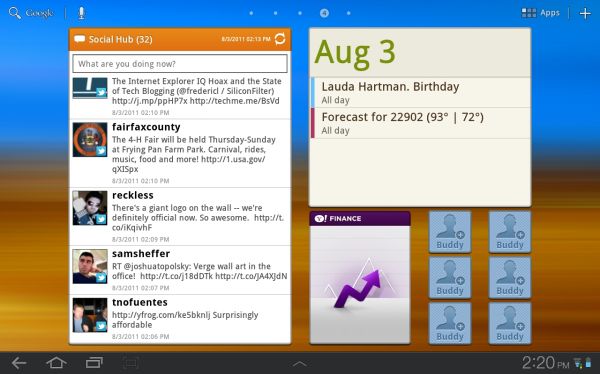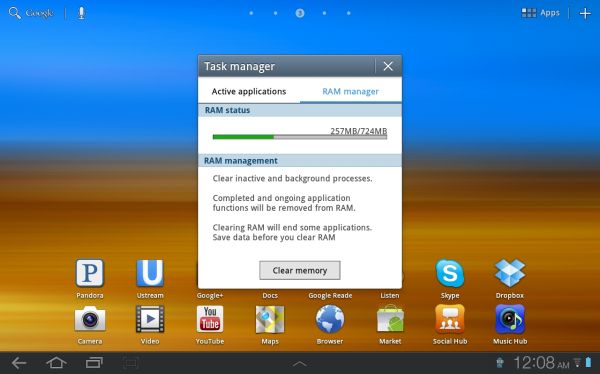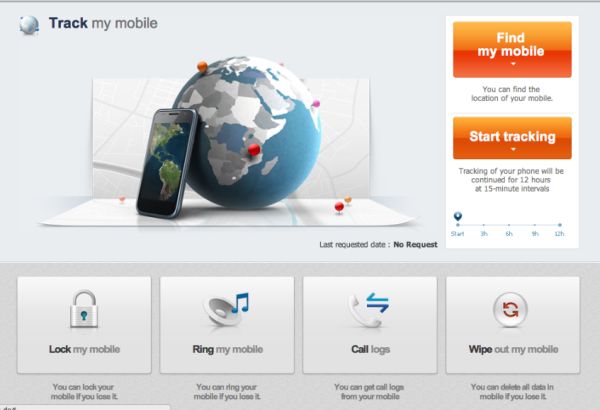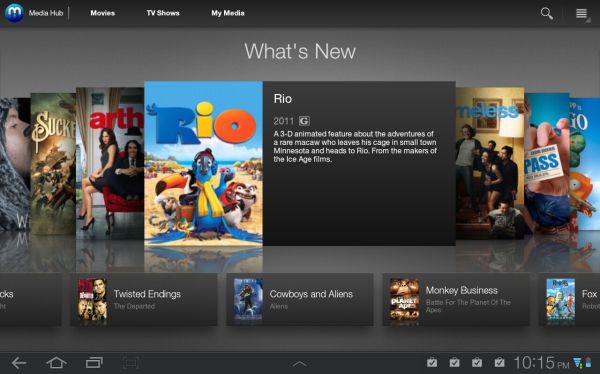Widgets and MiniApps (cont.)
All of the skins we can expect to see on Honeycomb will include widgets that offer added functionality - or rather, that’s what they intend to do. The concern is that the performance penalty for running these applications can be worse than the value they add. The interesting thing is that with sales of Honeycomb tablets less than startling, app developers haven’t exactly filled the app store with high quality tablet optimized apps the likes of which populate millions of iPads. So, there’s an opportunity for manufacturer’s to fill that void with their own stylized apps. So, how did Samsung do with Live Panels?

The most dominant Live Panel is Social Hub, a messaging and social media aggregator, think TweetDeck but without the power functions. Once you’ve added your accounts the widget populates with your friends latest posts, and allows a field for you to post, as well as the ability to reply to or repost friend’s posts. This widget, and all the Samsung widgets, are resizable, so you can fit them to whatever space is most convenient. And the main application also allows you to read and send direct messages from linked social media accounts. And there-in lies the potential rub. This, and each of the other widgets, is running the full application and feeding the widgets with data. We’ll cover the rest of the widgets briefly but I just want to touch on what this means for performance.

This screen shot shows the RAM use with a freshly booted Tab; the only open applications are the ones operating the widgets. Clicking the ‘Clear memory’ button kills 20 applications and frees up ~80MB of RAM . . . and stops updating the widgets. Having more than half your RAM filled at boot is less than ideal. And though Google’s memory management is capable of shuttling inactive apps out of RAM whenever the space is needed, the footprint of these widgets will persist because whenever you go to one of your home screens all of the apps will reopen in the background so they can populate the widgets.
Ok, so what of the rest of the Live Panels? The weather app is fed by AccuWeather.com, and provides visuals not quite so bold as HTC’s Sense, but not unattractive or useless. A basic clock provides quick access to the alarm function, and a gallery widget cycles through previously selected pictures. A calendar widget provides your day’s schedule and an e-mail widget provides access to inboxes you’ve configured in the Honeycomb e-mail app, but not the Gmail app. Utility, isn’t bad amongst all of these, and the novelty of being able to resize each can enhance that utility in some instances. But there is a performance penalty, particularly when a widget laden home screen reloads, either after switching from an app or from a different home screen. The slow down isn’t egregious and it’s not much different from what we had seen on other Android tablets, but given that Samsung’s slate was the closest to the iPad’s smoothness the sudden juddery behavior was surprising. But there’s good news, you can turn the widgets off.

Find my Mac- er, Mobile
Samsung is also launching a device recovery service, courtesy of their Samsung Dive website. Users create an account with the service, and then register their device through the settings menu. Once registered users can locate, track, lock and remotely wipe and ring their device. This service is premiering on the 10.1 but will be available on future Samsung handsets and tablets. 
Content is King

It’s no longer good enough to provide hardware and software, users want to consume content so manufacturers have to provide. Samsung will be stepping into the breach and introducing their own content services, Music Hub and Media Hub. Their Music Hub service is familiar to us from their handset TouchWiz implementation and is powered by 7digital. The service and corresponding software won’t likely disturb Apple’s nor Amazon’s place in digital music sales but provides a good selection of popular music and tolerable user interface.
The new piece is Media Hub, a digital storefront for video content. The software is smooth and finding content is a relatively painless process. Content partners include the broadcast networks along with many cable networks and a decent selection of recent movies. Samsung stated that HD and SD content would be available through the service, though either the HD component was not yet live, or there seems to be no way to know whether the item you’ve selected is in HD or SD. The content we previewed looks good on the 10.1’s vivid screen, though all of it was SD, so blockiness was prevalent.



























30 Comments
View All Comments
migfig - Friday, August 5, 2011 - link
And your closing statement for TouchWiz on Honeycomb is about Appple? smhzeagus - Friday, August 5, 2011 - link
I think it's a valid point. The only competition is Apple, and the ending thought, though perhaps strangely structured is that the author hopes this helps Android devs to be able to do amazing things to compete and to keep the level of competition high so we, as consumers win. They need to do something, since the numbers backtracking game shows that something like 964 of every 1000 tablet pageviews on the web is viewed from an iPad.amf66 - Friday, August 5, 2011 - link
Did you even read the last paragraph? It's about how competition is good and how he hopes that innovation in Android will force Apple to innovate as well.Lurk moar.
FlyBri - Friday, August 5, 2011 - link
TouchWiz is not the first skinned Honeycomb experience...the Asus Transformer had the first skinned Honeycomb experience. It might have been lightly skinned, but skinned nonetheless.mlj11 - Friday, August 5, 2011 - link
"Samsung is also launching a device recovery service, courtesy of their Samsung Dive website... This service is premiering on the 10.1 but will be available on future Samsung handsets and tablets."Incorrect. This has been available on my international SGSII out of the box.
Also, I think Samsung's Bada phones may have had access to it even earlier.
mongo lloyd - Friday, August 5, 2011 - link
Yeah. It's been available on the original SGS (international version) for a while as well.solipsism - Friday, August 5, 2011 - link
… it's about the competition getting a real slice of the tablet market. The way things are going and the aggressiveness Apple showed at their iPad 2 special event earlier this year points to Apple wanting the iPad to be another iPod in market dominance, not an iPhone.Even though the iPhone does take 2/3rds of the world's handset profits Apple move is clearly to make the tablet market an iPad market with not only revenue and profit domination, but unit marketshare domination. A natural monopoly. The window for non-Apple tablets is closing.
If Apple can release a 2048x1536 iPad for the same price points it's a done deal for the foreseeable future.
JasonInofuentes - Friday, August 5, 2011 - link
We're hoping that's not the case. As Brian has pointed out, the lead time on tech innovation has typically been about 15-18 months. This appears to be getting faster. In addition, the fierceness of the competition has made each of these manufacturer's try harder, both in the phone and tablet space. HTC is putting out some stunning designs with a variety of body types and construction techniques. Motorola has produced consistently effective designs and strived to stretch Android beyond the phone with WebTop. Samsung has produced a stunning device that will, eventually, be available on every US carrier, as it did with the first Galaxy S. Even LG has strived to innovate with the first dual-core phone (ostensibly) and the first 3D phone.So basically, as much as my review ends on a bit of a down note, every single one of these manufacturers is running on all eight cylinders. They are racing to the finish, and we're going to get to enjoy the ride.
name99 - Saturday, August 6, 2011 - link
You're assuming that people buy tablets because of the hardware. This seems a dubious assumption.What Apple HAD in the past was
- hardware that worked well and did not feel cheap. The competitors are headed there but aren't there yet
- software that worked well. The competitors aren't close to that (read this review, which is full of apologies for crashes, slowness, poor resource usage), and by the time they have reached where Apple is now, iOS will be at version 5.
- a media infrastructure that works well. Android still doesn't have that; what they have is a bunch of more or less lame media player apps, and a completely fragmented media market.
What Apple WILL have soon is iCloud, not in the stupid sense of a smarter dropbox, but in the sense of an infrastructure (servers, protocols, APIs, design patterns) to allow apps on multiple devices to synchronize their behavior. Naturally Android (and MS) will try to copy it, but once again they will be lagging Apple by a year.
cr1b - Sunday, August 7, 2011 - link
Win 98 is fast but its very ugly. The same on iOS. Comeon man iOS only have to show 5 screens of icons with no widggets or animations and for the price of the devices its the minimal result that they can deliver.I give you the web browsing experience witch in better but no more.